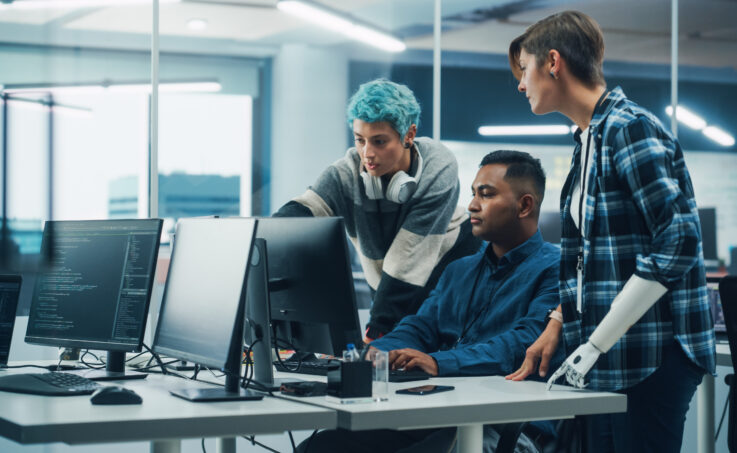From Disability to Inclusion - Reading Materials - Chapter 07: Leading & Promising Practices
Introduction

Encouraging Opportunities through Diversity Planning at Hydro Ottawa Holding Inc.
Hydro Ottawa owns and operates two subsidiary companies, Hydro Ottawa Limited and Energy Ottawa Inc. Hydro Ottawa Limited is the 3rd largest municipally-owned electrical utility in Ontario, serving more than 324,000 customers in the City of Ottawa and the Village of Casselman. Energy Ottawa Inc., the largest municipally-owned producer of green power in Ontario, generates renewable energy and provides commercial energy-management services. Our core businesses are electricity distribution, renewable energy generation, and energy conservation and management services. We are a recognized leader for our environmental sustainability, strategically-aligned community investments, innovation in customer communication, and employment experience.
Our foundational initiatives foster an underlying culture of inclusion practices in our environment and address leadership alignment, communication, employee involvement and training – all of which are essential for success.
Hydro Ottawa’s vision is to be a leading partner in a smart energy future. Our mission is to create long-term value for our shareholder, benefitting our customers and the communities we serve. With that mission in mind, Hydro Ottawa’s 2016-2020 Strategic Direction sets out a balanced program for strong performance in our existing operations, coupled with sustainable and profitable business growth. Our strategy is customer-centric, financially responsible, and responds to a strategic environment that will further strengthen our commitment to enhancing customer value while growing our business at the same time.
Name of Program, Policy or Initiative: Persons with Disabilities Initiatives
At Hydro Ottawa, we understand that in order for our organization to recruit and retain a diverse workforce we have to think strategically about our business needs, and most importantly, involve our employees in the process. This led to the development of our first ever Diversity Plan, as part of our Talent Management Strategy, which was created to align with Hydro Ottawa’s 2012-2016 Strategic Direction.
The objectives of the Diversity Plan are centred around attracting, retaining, and engaging employees while supporting the company’s focus on customer value, organizational effectiveness, and corporate citizenship. The Diversity Plan focuses on a wide range of diversity groups: Women, Members of Visible Minorities, Persons with Disabilities, Youth, LGBT, and New Canadians, with First Nations being added in 2015.
Our Diversity Plan, developed by a working group of employees, has two main elements – foundational initiatives intended to foster overall inclusion, and specific initiatives targeted towards our identified diversity groups.
For example, a variety of training initiatives are provided to existing employees and those joining our organization, to further share and explore organizational culture and values that promote a diverse and inclusive workplace.
Guided by our Diversity Council, we have already launched many targeted initiatives, with plans to continue implementing more over the course of 2016. Hydro Ottawa’s Diversity Council, co-sponsored by two executives and comprised of volunteer employees from across the organization, is an advisory body on all things diversity. The Council advises on how we can continue to drive progress on diversity and inclusion at Hydro Ottawa, engage our employees in diversity initiatives and monitor performance in the implementation of our Diversity Plan.
Success Factors
- Top priority of our President and CEO which means that he has been and continues to be visible, supportive and involved with diversity matters. The same support is provided by our Board of Directors who receive regular updates on our progress.
- Champions at all levels (employee, management, and executive levels) and within different divisions and work centres.
- Involving employees in the creation of the Diversity Plan and the initiatives – as they are defined and as they are rolled out.
- Getting involved in the community (including EARN).
- Understanding that mindsets need to change as well as behaviours.
Lessons-Learned
During the initial development and launch of our 2014-2016 Diversity Plan, there was some resistance from employees. Generally speaking, resistance was due to lack of knowledge and education, misunderstandings of what diversity is and trepidation about what it meant. For example, employees were concerned about whether or not there were quotas and what the purpose or intent was behind the launch of a diversity plan. The consultative process to involve employees, taking an incremental approach with our initiatives, and the importance of educating and communicating with employees became very apparent as key to ensuring success.
Throughout our 2014-2016 Diversity Plan, our focus was on communicating and educating and through our diversity council and sub-groups, finding champions to create a broad base of support. As a result, we are now well positioned to continue to implement the initiatives outlined in our original Plan and provide leadership in the development and implementation of our 2017-2020 Diversity Plan which is currently underway. It is important however that our champions continue to find the right balance between their diversity work and their ongoing duties.
What’s Next?
We are committed to creating a more diverse and inclusive workplace for persons with disabilities and our 2017-2020 Diversity and Inclusion Plan is currently under development to ensure this journey continues. The focus of the Accessibility Committee is now on continuing to move our organization from a culture of compliance to one of inclusion and to that end, on detailing specific initiatives for the 2017-2020 period.

Broader Application
What is the key recommendation you would make to any organization who seriously wants to invest in this area?
- Understand that the majority of workplace accommodations cost less than $500.
- Know that it is as much about attitude and culture as it is about architecture.
- Start slow, involve and engage employees – educate, educate, educate.
- Solicit senior level support and “grass roots” support simultaneously.
Hydro One
During our research on the Enable Change project we have come across one example of a very innovative and exciting program that, while not officially a ‘mentoring program’ exhibits all the positive traits of one. The Accessibility, Inclusivity and Disability (AID) Network at Hydro One is an informal peer support and advocacy group for employees in the workplace with a range of disabilities in a range of jobs who come together regularly to share knowledge, experience, and connections with anyone who wants to join.
Together they work towards shared learning and understanding and help each other through some of the challenges they may be experiencing in the workplace as a result of their disability whether acquired prior to or on the job. The network also serves as a forum for organizational change and management guidance in ensuring appropriate accessibility accommodations and practices are implemented e.g. accessibility considerations in organizing and planning special events.
Manitoba Hydro
Manitoba Hydro participates in a transitional employment program called Project Search to provide work placements for high school students with intellectual disabilities in their final year of school — the program is offered in partnership with a non-profit organization, SCE Lifeworks.
For over a decade, Manitoba Hydro has managed an Acquired Brain Injury Program to help persons who have sustained severe brain injury reintegrate into the workforce — the program partners with support agencies such as the Manitoba Brain Injury Association and features customized vocational assessment, training and job coaching.
SaskPower
SaskPower maintains a diversity department that is responsible for developing programs and initiatives to improve workplace diversity and inclusion as well as a joint diversity committee, comprised of representatives from unionized and management employee groups — the committee also consults with five employee affinity groups, which are responsible for implementing initiatives related to their respective focus. SaskPower’s Network for Employees with Disabilities recently helped review the organization’s recruitment process for inclusion and help remove potential barriers to access.
Enbridge
Enbridge manages the “Oasis Coordinator Project”, which employs adults with developmental disabilities to maintain kitchen space in the company’s office towers. In addition, Enbridge is engaged in diversity community partnerships such as the National Education Association for Students with Disabilities (employment workshop for students).